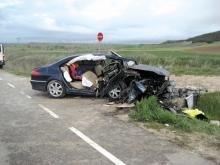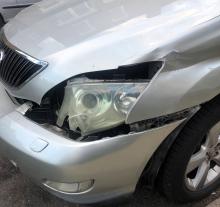The European Commission’s latest figures for road safety reveal some cause for concern across the EU. While the EU has the world’s safest roads overall, the road fatality rate has slipped during 2015. And this is for the second consecutive year also as EU road deaths in 2014 also showed an increase over 2013. By comparison, there were decreases in the European road death rate of 8% in 2012 and 2013.
The European Commission’s latest figures for road safety reveal some cause for concern across the EU. While the EU has the world’s safest roads overall, the road fatality rate has slipped during 2015. And this is for the second consecutive year also as EU road deaths in 2014 also showed an increase over 2013. By comparison, there were decreases in the European road death rate of 8% in 2012 and 2013.
The European Commission’s data show road deaths in the EU increased by 1% to around 26,000 in 2015, when compared to 2014. This equates overall to 51.5 road deaths/million inhabitants, an increase of 0.5 for the 2014 figure. However it still compares well against the road death rate in the US of 106/million or the worldwide road death average of 174/million.
“We have achieved impressive results in reducing road fatalities over the last decades but the current stagnation is alarming,” said EU Transport Commissioner Violeta Bulc.
Malta has the safest roads in Europe, at 26 deaths/million of population. Sweden saw a drop in deaths of 2% to 27/million. The Netherlands has published its road safety figures alongside other EU countries for the first time this year, with it remaining stagnant at 28 deaths/million. Meanwhile, despite a fall in road deaths of 1%, the UK stays at 29 deaths/million. Moving up into the top group for the first time is Denmark with a significant 8% improvement to 30 deaths/million.
Spain has made significant gains in recent years but its road death rate remains 36/million, with a similar figure for Ireland which cut road deaths by 15% in 2015. Germany had 43 road deaths/million, an increase of 3% during last year. France remains above the EU average at 54 deaths/million. Luxemburg has 58 road deaths/million of population, an improvement in road safety of 9%. But Belgium continues to have amongst the worst road casualty rates in Western Europe with 67 deaths/million, a 4% rise from last year.
But at the other end of the spectrum there are clearly issues in the Baltic States. Latvia had a worrying 94 road deaths/million while Lithuania had 82 road deaths/million of population, despite cuts in deaths of around 10% each. Estonia has seen a 15% cut in road fatalities however, with 50 deaths /million inhabitants. Poland has made improvements in recent years. From a death rate of 102/million in 2010, last year that was reduced to 77/million.
The highest road casualty rates in Europe are for Romania and Bulgaria, both with 95 road deaths/million inhabitants, and both showing an increase of 4% in fatalities from the previous year.
The 2015 road safety statistics published by the European Commission do show improvements though. The 26,000 killed on EU roads in 2015 shows a gain in safety from the 31,500 killed in 2010. But there has been no improvement across the EU compared to 2014, while 135,000 people were seriously injured on EU roads. The social cost (rehabilitation, healthcare and material damages) of road fatalities and injuries is estimated to be at least €100 billion.
Bulc said, “If Europe is to reach its objective of halving road fatalities by 2020, much more needs to be done. I invite Member States to step up efforts in terms of enforcement and campaigning. This may have a cost, but it is nothing compared to the €100 billion social cost of road fatalities and injuries. Technology and innovation are increasingly shaping the future of road safety. In the medium to long term, connected and automated driving, for instance, has great potential in helping to avoid crashes, and we are working hard to put the right framework in place.”
Over the last decades, the EU has made progress in reducing road fatalities. Between 2001 and 2010, Europe cut the number of road deaths by 43% in spite of the increased traffic volumes, and reduced it by another 17% since 2010.
The slowdown marking the last three years certainly has several contributing factors. Some of them are evident, based on statistics: a higher interaction between unprotected and motorised road users in our cities, and an ever growing number of elderly people in road traffic. Some other causes commonly referred to are urbanisation with a growing number of vulnerable road users; an increase of traffic during milder winters in Europe; less resources dedicated to road maintenance and vehicles following the economic crises; and last but not least the appearance of new trends in users’ behaviour, such as distraction mainly by mobile phones.
For every person killed in traffic crashes, many more suffer serious injuries with life-changing consequences. The serious injuries are more common but also often more costly to the society because of long-time rehabilitation and healthcare needs. Vulnerable road users, such us pedestrians, cyclists, motorcyclists or elderly road users are especially affected.
Building on this progress in data collection, the Commission will be able to monitor and benchmark Member State performance and assess how to further stimulate it. Also, the new data shows that fatal crashes and crashes resulting in serious injury have slightly different characteristics. This will help to see where more work is needed, such as on safety for vulnerable road users or safety in urban areas.
Vulnerable road users such as pedestrians and cyclists also account for a large proportion of the 135,000 injured. Some 22% of all people killed on the roads are pedestrians, and pedestrian fatalities decreased slower than other fatalities (by 11% from 2010 to 2014, compared to the total fatality decrease of 18%). The share of pedestrian deaths is especially high in Romania, Latvia, Estonia, Poland and Lithuania where more than a third of all killed in road traffic crashes are pedestrians.
Cyclists make up 8% of all who died on the road in the EU. The number of cyclist fatalities decreased by only 4% between 2010 and 2014, which is much lower than the total fatality decrease (18%). There were significant differences between Member States. The share of cyclist deaths is especially high in the Netherlands (25%), as well as in Denmark and Hungary (16%). The differences of course mirror the popularity of cycling in different Member States but also the safety of bike paths, the safety awareness of cyclists themselves and the awareness among drivers of the safety of surrounding cyclists.
Motorcyclists make up 15% of road fatalities. This reflects the fact that riders are less protected in case of a crash. There are big differences between Member States. The share of motorcyclist deaths is especially high in Greece (31%), Italy (21%), France (19%), Austria (18%), Spain (17%) and Germany (17%).
Men are overrepresented among road victims: 76% of all who die in road traffic crashes. The young still face the largest risk in traffic: those between 15 and 24 years make up 11% of the population but 16% of all road fatalities. However, in the last years fatalities among young road drivers have decreased by 32% between 2010 and 2014, more than for any other age group. In parallel, the share of road deaths of elderly people (9%) has decreased only by 3%.
Member States are the main actors in reducing fatalities as the biggest part of road safety policies fall under the principle of subsidiarity. To reach the strategic target of halving the number of road deaths by 2020, Member States need to step up actions, addressing infrastructure and vehicles safety, and in particular focusing on awareness-raising and education, as well as efficient enforcement of traffic rules.
The EU has created a general framework for improved road safety with legislation and recommendations. Key measures include minimum requirements for the safety management of the Trans-European Transport Networks and technical requirements for safe transport of dangerous goods. Most recent initiatives include the cross-border enforcement directive to tackle driving offences committed abroad, and new legislation on roadworthiness testing to decrease the number of traffic crashes caused by technical failures.
A study launched in October 2015 analyses crashes causing serious injury in order to identify a number of the most common crash scenarios with serious injuries as an outcome. Results should be available by November 2016.
The SafetyCube research project funded under Horizon 2020 aims to support the selection and implementation of strategies and measures to reduce casualties in Europe and worldwide. The project includes a comprehensive analysis of accident risks, and it will provide guidelines for the registration and monitoring of serious road injuries.
The Commission stimulates and supports Member States in their activities to improve road safety through different knowledge sharing platforms and activities, such as the High Level Group on Road Safety, country visits, peer-reviews or the European road safety days. These occasions bring together policy-makers, experts, NGOs and the industry. The Commission has furthermore created and runs the European Road Safety Charter, a large platform, with more than 2800 members today, that mobilises public and private entities as well as the civil society in all the 28 EU countries for voluntary commitments to road safety actions.
The European Commission’s data show road deaths in the EU increased by 1% to around 26,000 in 2015, when compared to 2014. This equates overall to 51.5 road deaths/million inhabitants, an increase of 0.5 for the 2014 figure. However it still compares well against the road death rate in the US of 106/million or the worldwide road death average of 174/million.
“We have achieved impressive results in reducing road fatalities over the last decades but the current stagnation is alarming,” said EU Transport Commissioner Violeta Bulc.
Malta has the safest roads in Europe, at 26 deaths/million of population. Sweden saw a drop in deaths of 2% to 27/million. The Netherlands has published its road safety figures alongside other EU countries for the first time this year, with it remaining stagnant at 28 deaths/million. Meanwhile, despite a fall in road deaths of 1%, the UK stays at 29 deaths/million. Moving up into the top group for the first time is Denmark with a significant 8% improvement to 30 deaths/million.
Spain has made significant gains in recent years but its road death rate remains 36/million, with a similar figure for Ireland which cut road deaths by 15% in 2015. Germany had 43 road deaths/million, an increase of 3% during last year. France remains above the EU average at 54 deaths/million. Luxemburg has 58 road deaths/million of population, an improvement in road safety of 9%. But Belgium continues to have amongst the worst road casualty rates in Western Europe with 67 deaths/million, a 4% rise from last year.
But at the other end of the spectrum there are clearly issues in the Baltic States. Latvia had a worrying 94 road deaths/million while Lithuania had 82 road deaths/million of population, despite cuts in deaths of around 10% each. Estonia has seen a 15% cut in road fatalities however, with 50 deaths /million inhabitants. Poland has made improvements in recent years. From a death rate of 102/million in 2010, last year that was reduced to 77/million.
The highest road casualty rates in Europe are for Romania and Bulgaria, both with 95 road deaths/million inhabitants, and both showing an increase of 4% in fatalities from the previous year.
The 2015 road safety statistics published by the European Commission do show improvements though. The 26,000 killed on EU roads in 2015 shows a gain in safety from the 31,500 killed in 2010. But there has been no improvement across the EU compared to 2014, while 135,000 people were seriously injured on EU roads. The social cost (rehabilitation, healthcare and material damages) of road fatalities and injuries is estimated to be at least €100 billion.
Bulc said, “If Europe is to reach its objective of halving road fatalities by 2020, much more needs to be done. I invite Member States to step up efforts in terms of enforcement and campaigning. This may have a cost, but it is nothing compared to the €100 billion social cost of road fatalities and injuries. Technology and innovation are increasingly shaping the future of road safety. In the medium to long term, connected and automated driving, for instance, has great potential in helping to avoid crashes, and we are working hard to put the right framework in place.”
Over the last decades, the EU has made progress in reducing road fatalities. Between 2001 and 2010, Europe cut the number of road deaths by 43% in spite of the increased traffic volumes, and reduced it by another 17% since 2010.
The slowdown marking the last three years certainly has several contributing factors. Some of them are evident, based on statistics: a higher interaction between unprotected and motorised road users in our cities, and an ever growing number of elderly people in road traffic. Some other causes commonly referred to are urbanisation with a growing number of vulnerable road users; an increase of traffic during milder winters in Europe; less resources dedicated to road maintenance and vehicles following the economic crises; and last but not least the appearance of new trends in users’ behaviour, such as distraction mainly by mobile phones.
For every person killed in traffic crashes, many more suffer serious injuries with life-changing consequences. The serious injuries are more common but also often more costly to the society because of long-time rehabilitation and healthcare needs. Vulnerable road users, such us pedestrians, cyclists, motorcyclists or elderly road users are especially affected.
Building on this progress in data collection, the Commission will be able to monitor and benchmark Member State performance and assess how to further stimulate it. Also, the new data shows that fatal crashes and crashes resulting in serious injury have slightly different characteristics. This will help to see where more work is needed, such as on safety for vulnerable road users or safety in urban areas.
Vulnerable road users such as pedestrians and cyclists also account for a large proportion of the 135,000 injured. Some 22% of all people killed on the roads are pedestrians, and pedestrian fatalities decreased slower than other fatalities (by 11% from 2010 to 2014, compared to the total fatality decrease of 18%). The share of pedestrian deaths is especially high in Romania, Latvia, Estonia, Poland and Lithuania where more than a third of all killed in road traffic crashes are pedestrians.
Cyclists make up 8% of all who died on the road in the EU. The number of cyclist fatalities decreased by only 4% between 2010 and 2014, which is much lower than the total fatality decrease (18%). There were significant differences between Member States. The share of cyclist deaths is especially high in the Netherlands (25%), as well as in Denmark and Hungary (16%). The differences of course mirror the popularity of cycling in different Member States but also the safety of bike paths, the safety awareness of cyclists themselves and the awareness among drivers of the safety of surrounding cyclists.
Motorcyclists make up 15% of road fatalities. This reflects the fact that riders are less protected in case of a crash. There are big differences between Member States. The share of motorcyclist deaths is especially high in Greece (31%), Italy (21%), France (19%), Austria (18%), Spain (17%) and Germany (17%).
Men are overrepresented among road victims: 76% of all who die in road traffic crashes. The young still face the largest risk in traffic: those between 15 and 24 years make up 11% of the population but 16% of all road fatalities. However, in the last years fatalities among young road drivers have decreased by 32% between 2010 and 2014, more than for any other age group. In parallel, the share of road deaths of elderly people (9%) has decreased only by 3%.
Member States are the main actors in reducing fatalities as the biggest part of road safety policies fall under the principle of subsidiarity. To reach the strategic target of halving the number of road deaths by 2020, Member States need to step up actions, addressing infrastructure and vehicles safety, and in particular focusing on awareness-raising and education, as well as efficient enforcement of traffic rules.
The EU has created a general framework for improved road safety with legislation and recommendations. Key measures include minimum requirements for the safety management of the Trans-European Transport Networks and technical requirements for safe transport of dangerous goods. Most recent initiatives include the cross-border enforcement directive to tackle driving offences committed abroad, and new legislation on roadworthiness testing to decrease the number of traffic crashes caused by technical failures.
A study launched in October 2015 analyses crashes causing serious injury in order to identify a number of the most common crash scenarios with serious injuries as an outcome. Results should be available by November 2016.
The SafetyCube research project funded under Horizon 2020 aims to support the selection and implementation of strategies and measures to reduce casualties in Europe and worldwide. The project includes a comprehensive analysis of accident risks, and it will provide guidelines for the registration and monitoring of serious road injuries.
The Commission stimulates and supports Member States in their activities to improve road safety through different knowledge sharing platforms and activities, such as the High Level Group on Road Safety, country visits, peer-reviews or the European road safety days. These occasions bring together policy-makers, experts, NGOs and the industry. The Commission has furthermore created and runs the European Road Safety Charter, a large platform, with more than 2800 members today, that mobilises public and private entities as well as the civil society in all the 28 EU countries for voluntary commitments to road safety actions.







